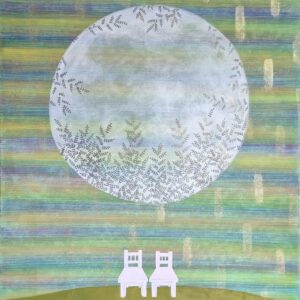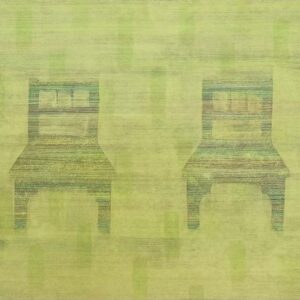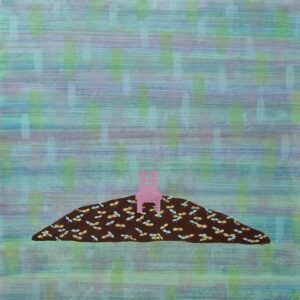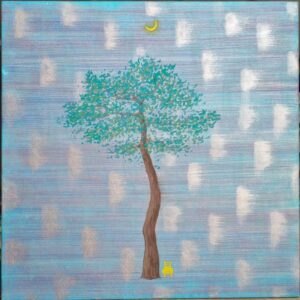One to Watch
 Seonmi Kang Finds Rest Beneath the Moon
Seonmi Kang Finds Rest Beneath the Moon
Korean artist Seonmi Kang uses traditional Korean materials to create her ethereal paintings. Drawing on elements of nature, Seonmi creates tranquil spaces of rest for the viewer. Seonmi received her MFA from Jeonbuk National University and has exhibited extensively in both group and solo shows. Keep reading to learn more about her work, inspirations, and process.
Tell us about who you are and what you do. What’s your background?
I am Seonmi Kang, and I am based in Korea. I have loved the storybooks of artists since I was young. I used to express my observations, thoughts, and feelings about my surroundings by sketching them on the board. I started studying painting in high school and went to Jeonbuk National University to obtain a bachelor’s degree in Korean painting. Interested in art education, I went on to graduate school of education and received a master’s degree in art education. While teaching children, I feel and empathize with their pure imagination.
What does your work aim to say? What are the major themes you pursue in your work?
I’m working with the goal of creating a “rest space.” Rest is like a generator that can fill energy in a depleted body and mind. My work is to provide a rest to me or people who are tired in their daily lives and to give the driving force to start over. I find rest in nature, as it changes from moment to moment and gives mystery to colors and shapes. From a simple perspective, there is nature right outside the house: trees, stones, seas, skies, the sun, the moon, etcetera. I notice the changing colors, shapes, and air throughout the spring, summer, fall, and winter soothe and fill our eyes and minds. I want to draw from this natural space and present a “rest space.”
Can you walk us through your process for creating a work from beginning to end?
For my work, I use traditional Korean paper and traditional Korean paint. Jangji––a type of Korean paper––is sprinkled with water, put on the wooden frame, dried, and then sprinkled with glue water again. After applying the background paint on the dry Jangji, I repeat the drying process twice. I use a brush to roughly print on a dry background or a flat brush to gently create several thin lines. This process is usually repeated five to six times. It is a process of densely expressing the colors felt in nature throughout the composition, and it is important that the colors harmonize without clashing.
After the background process, the trees are added and the color of the wood is printed using a brush, like the process used in the background. The colors of the trees are drawn five to six times, sometimes by overlapping several colors more than that, while adjusting the strength and weakness of the brush’s touch. Finally, the moon and the flowing moonlight are drawn. The moon lights up the night and, in Korea, we make a wish to the moon and gain comfort. I hope the viewer can get comfort from the natural shelter that is represented by the colors of nature and the mysterious energy of the moon.
Who are your biggest influences, and why?
I try to see a lot of works by artists of the Impressionist style. The colors of nature felt in the air and the flow of time are so delicate and beautiful that it is difficult to express them. Even when I walk on the street, I try to feel the colors of the sky, trees, and light with my mind and eyes by carefully observing them. In addition, I try to learn simplicity in the formative elements. The sophisticated and humorous formative elements of the painter Chang Ucchin show the power of simplicity. It is simple but it is never empty, and the relaxation felt in the space brings comfort and laughter to the viewer. I am trying to express these implicit formative elements in my painting.
How does your work comment on current social and political issues?
Rather than dealing with political and social issues, I would like to give quiet comfort to those who are separated by such ideologies. Just as feelings that used to be cold to each other can be warmed up when the mind is at ease, the power of culture and art is thought to have the ability to warm up the heart. I hope it will be a peaceful world.
How do you hope viewers respond to your works? What do you want them to feel?
Relaxed! I hope my work provides a break from the busy and tired daily life for a while. I want the viewer to feel comfortable and relaxed in a natural space. When you are tired of your hard daily life and cannot move a single stroke, pause for a while, rest, and gain the energy to step back on your feet.
What was the best advice given to you as an artist?
For me, being an artist was an unanswered problem. It felt like homework that didn’t end, no matter how hard I tried. I tried to run towards the finishing line like a mirage in the desert, but I couldn’t get there. When I was tired and exhausted, a professor I met said, “The departure may be the same, but the arrival point is all different.” My destination is what I decide! I hope I can go all the way even if I take a rest.
Do you prefer to work with music or in silence?
Music is my mental stability––I like to listen to music that is chosen according to my mood. While listening to music, various emotions are maintained at a certain line, and the melody contained in the music also brings another inspiration when working.












